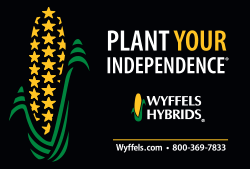|
Partnership Strengthens NRCS Outreach in Illinois, Boosting Farmer
Access to Conservation Funding
 Send a link to a friend
Send a link to a friend
[November 14, 2024]
BLOOMINGTON, Ill. - Illinois soybean farmers
will now have additional education opportunities, agronomic
guidance, and assistance with evaluating field data to better
implement conservation practices that benefit the environment.
|
|
 The Illinois Soybean Association (ISA) has entered into a
matching $750,000 contribution agreement with the United States
Department of Agriculture-Natural Resources Conservation Service
(USDA-NRCS) for a total of $1.5 million to fund increased
education and adoption of climate-smart practices that will help
increase carbon sequestration and reduce greenhouse gases. ISA
will use part of the funding to hire additional staff, including
agronomists, to help manage the efforts. The ISA Agronomy Team
is responsible for cross-functional agronomic research and
education that creates opportunities for Illinois soybean
farmers to increase on-farm profitability and manage crop
production risks. Partnering with NRCS will help to increase
conservation education for farmers alongside additional
agronomic support from trusted ISA advisors. The Illinois Soybean Association (ISA) has entered into a
matching $750,000 contribution agreement with the United States
Department of Agriculture-Natural Resources Conservation Service
(USDA-NRCS) for a total of $1.5 million to fund increased
education and adoption of climate-smart practices that will help
increase carbon sequestration and reduce greenhouse gases. ISA
will use part of the funding to hire additional staff, including
agronomists, to help manage the efforts. The ISA Agronomy Team
is responsible for cross-functional agronomic research and
education that creates opportunities for Illinois soybean
farmers to increase on-farm profitability and manage crop
production risks. Partnering with NRCS will help to increase
conservation education for farmers alongside additional
agronomic support from trusted ISA advisors.
”We are excited to enter into this formal partnership agreement
with the Illinois Soybean Association,” said Tammy Willis,
Illinois NRCS State Conservationist. “By utilizing special
funding through the Inflation Reduction Act, we will be able to
enhance our partnership with ISA to bring more conservation
opportunities to the farmers in Illinois.”

“This new funding will create a unique opportunity for us to
help Illinois farmers connect to their available NRCS programs
while also strengthening NRCS outreach resources,” said Abigail
Peterson, CCA and ISA Director of Agronomy. “We want to
complement the tools and information growers need to implement
conservation practices with an agronomic focus.”
Climate-smart practices are on-farm actions that contribute to
environmental benefits such as improving soil health, reducing
soil erosion, suppressing excessive weed pressure, improving
nutrient uptake efficiency and optimizing water management.
These practices include¹:
- Reducing tillage
- Planting cover crops
- Applying precision ag technology
- Establishing wildlife habitats
- Enhancing grassed waterways
[to top of second column] |

“Illinois soybean growers can look forward to more educational
materials, workshops and assistance from new staff agronomists
in the coming months,” Peterson added. “We’re here to ensure
growers take advantage of every opportunity they have to enroll
in applicable NRCS programs. We understand it can be
complicated, but there is a value to navigating these funding
processes for the success of both Illinois farmers and Illinois
conservation.”
Find more information about upcoming partnership activities or
contact us at www.fieldadvisor.org.
1: Farmers.gov. Climate-Smart Agriculture and Forestry (CSAF)
Mitigation Activities List for FY2024 Fact Sheet, Washington
D.C. United States Department of Agriculture-Natural Resources
Conservation Service, November 2023.
The Illinois Soybean Association
(ISA) checkoff and membership programs represent more than
43,000 soybean farmers in Illinois. The checkoff funds market
development, soybean production and government relations
efforts, while the membership program, Illinois Soybean Growers
(ISG) and the Illinois Soybean Growers PAC actively advocates
for positive and impactful legislation for farmers at local,
state and national levels. ISA upholds the interests of Illinois
soybean farmers through promotion, advocacy, research and
education with the vision of becoming a trusted partner of
Illinois soybean farmers to ensure their profitability now and
for future generations. For more information, visit the website www.ilsoy.org and www.ilsoygrowers.com.
[Michael Whitmer
Illinois Soybean Association]
 |